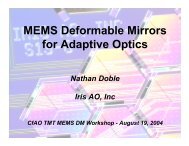PSF reconstruction for Keck AO - Laboratory for Adaptive Optics
PSF reconstruction for Keck AO - Laboratory for Adaptive Optics
PSF reconstruction for Keck AO - Laboratory for Adaptive Optics
You also want an ePaper? Increase the reach of your titles
YUMPU automatically turns print PDFs into web optimized ePapers that Google loves.
3 COMPONENT MODELING 23andσq 2 = 〈q T q〉 = 〈r T Q T Qr〉 + 〈n T Q T Qn〉 (94)= 〈r T Q T Qr〉 +Tr(Q T Q)σn, 2 (95)where σn 2 is the noise variance in a single sub-aperture, and we assumed that the noise is uncorrelated betweensub-apertures, i.e. the covariance matrix 〈nn T 〉 = σn 2 I is proportional to the identity matrix. The aliasing may becorrelated across the WFS however. There may be different ways of using this in<strong>for</strong>mation. If we had a model <strong>for</strong> thealiasing curl variance σq 2 r= 〈r T Q T Qr〉, we could measure the total curl variance σq 2 and solve <strong>for</strong> the noise variance:Autocorrelationσ 2 n = σ2 q − σ 2 q rTr(Q T Q) . (96)We investigate whether this can be done on the actuators, to get the propagated noise directly.cross-correlation as a function of time l isThe actuator∑NV xy (l) = N −1 (x i −〈x〉)(y i−l −〈y〉) (97)i=l= 〈(x i −〈x〉)(y i−l −〈y〉)〉 . (98)If the loop frame rate is much faster than the turbulence decorrelation time, then the noise level can be approximatedbyV xy (0) − V xy (1) = 〈(x 0 −〈x〉)(y 0 −〈y〉)〉−〈(x 1 −〈x〉)(y 0 −〈y〉)〉 (99)= 〈(x 0 − x 1 )(y 0 −〈y〉)〉 (100)= 〈(x 0 − x 1 )y 0 〉 , (101)where it was assumed that 〈x 0 〉 = 〈x 1 〉 by ergodicity. The result 101 is straight<strong>for</strong>ward to compute from TRS databy shifting the telemetry stream one time step, taking the difference and matrix multiplying with itself to give theactuator noise covariance matrix. This is similar to a high-bandwidth approximation, but we avoid the problem ofestimating centroid gains. At lower bandwidths or shorter turbulence coherence times, one needs to calculate thecross-correlation at a few more time steps, i.e. V xy (2),V xy (3) etc in order to extrapolate by curve fitting the noise-freecorrelation at the origin V xy ′ (0). The noise level is then estimated from V xy(0) − V xy ′ (0), but the remaining problemnot solved here is how to account <strong>for</strong> temporally filtered noise whose correlation function is not a delta function.3.8 Other componentsr 0 and L 0 estimationMethod implemented [32, 39], undergoing validation and testing. Algorithm <strong>for</strong> r 0 needs tuning – loop dynamicsnot taken out of the estimation (this problem almost exactly the same as the <strong>PSF</strong> <strong>reconstruction</strong> problem itself, andsuffers from the same approximations and limitations). Will try to data mine interferometer fringe tracker data <strong>for</strong>L 0 and correlate with MASS/DIMM measurements and model fitting to get more insights. (code <strong>for</strong> this)Static aberrationsKnown static aberrations may be included in the OTF calculation by adding a fixed component γ to the phase φ.This increases the computational load somewhat by making the OTF integrand complex valued, but should not bean issue. Since γ is not a stochastic variable, it can be taken outside of the ensemble average, and the OTF computedwith the modified pupil function P (x) → P (x)exp[iγ(x)]. These aberrations could include all types of common-patherrors, provided they can be measured or estimated somehow, such as <strong>for</strong> instance uncorrected segment aberrations.It is less clear to me how one would try to include non-common path aberrations, such as distortions in the NIRC2camera. After image sharpening, there will still be higher-order non-common path aberrations, and moreover these



